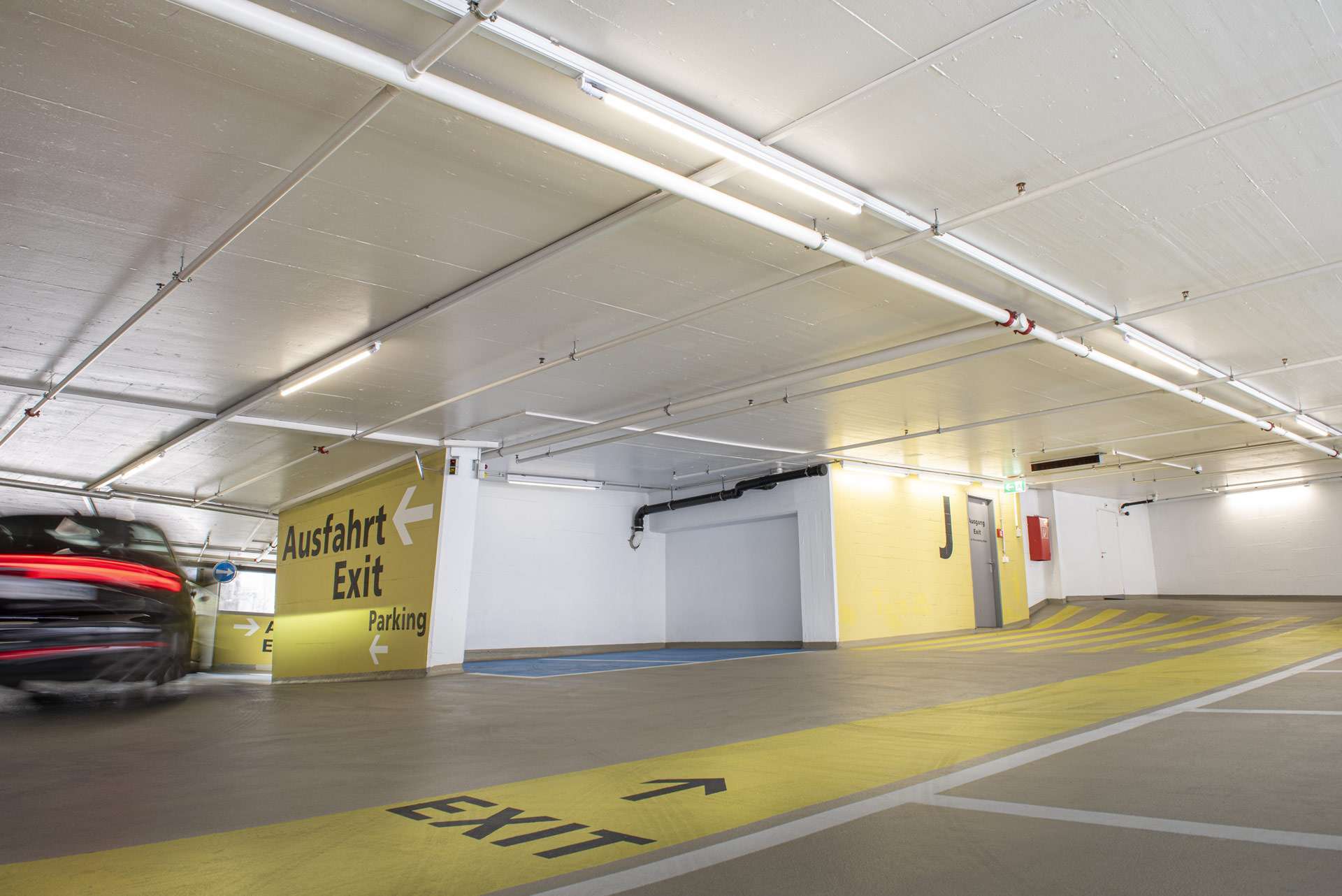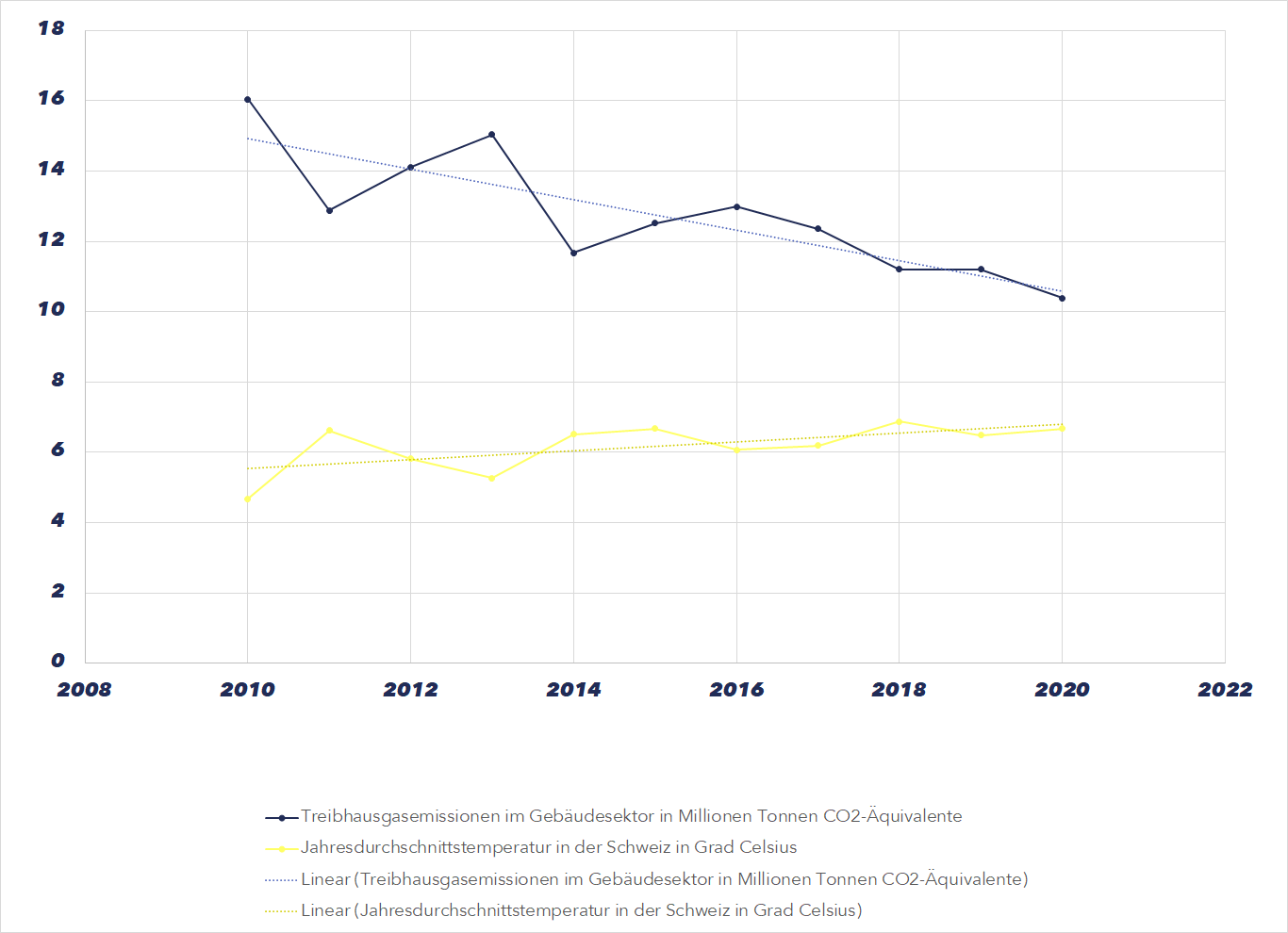
Blog Posts - 01.04.2025

Although many large companies have now set themselves net-zero targets, we received sobering news from Bern on 11 April 2022. Despite the pandemic, the warm winter and the record amount of funding, we are failing to meet our climate target of reducing greenhouse gas emissions in Switzerland by 40% by 2020 compared to 1990. As the building sector is responsible for more than 25 % of CO2 emissions, sustainable construction or renovation must continue to be promoted. But our neighbours to the north are also struggling with CO2 emission reduction targets: The German building sector exceeded the permitted annual emissions level in 2021. What are the challenges for players in the building sector? Why is the building sector also referred to as a climate problem child? Is the necessary innovation lacking?
The diminishing returns on property are probably not the only thing that concerns players in the building sector these days. In Switzerland, buildings consume around 40% of energy and were responsible for 23.9% of total CO2 emissions in 2020 according to the recently published greenhouse gas inventory of the Federal Office for the Environment – this corresponds to 10.38 million tonnes of CO2. Compared to the base year (1990), this corresponds to a reduction of 39 %. This means that the building sector has only just missed its emissions reduction target of 40 %, which the federal government set itself in 2011 with the CO2 Act. In the long term, the reduction trend will be characterised by the improved energy efficiency of new buildings and the renovation of existing buildings. In existing buildings, more and more oil and gas heating systems are being replaced by heat pumps. Renewable energies are also increasingly being used. However, the weather also has a significant influence on annual emissions. In milder temperatures, significantly fewer fossil fuels are used for heating purposes. For example, 2010 was a significantly colder year compared to 2011, with an average annual temperature of 4.68 degrees Celsius. Accordingly, 3.16 million tonnes more CO2 equivalents were emitted in 2010 than in 2011. How much of this reduction we owe to the average annual temperature and how much is due to the measures to reduce greenhouse gas emissions cannot be definitively said. The fact is, however, that there is a positive feedback loop.

The trend that CO2 emissions and energy consumption are being reduced – but not fast enough – is not unique to Switzerland. This trend is also evident in Germany, according to the Federal Ministry for Economic Affairs and Climate Protection: While the building sector was responsible for 210 million tonnes of CO2 in Germany in 1990, this figure will be “only” 115 million tonnes of CO2 equivalents in 2021. CO2 emissions have therefore been reduced by slightly less than 43%. Nevertheless, the building sector still exceeds the permitted annual emission volume of 113 million tonnes of CO2 and is therefore still responsible for almost 30% of all CO2 emissions. By 2030, the German government in Berlin has set itself the target of limiting the emissions caused by buildings to 67 million tonnes of CO2 – almost halving them again. The ambitions are therefore clear. A lot has been done in recent years in terms of sustainability – there are numerous examples where people and companies have achieved extraordinary things. However, if these goals are to be achieved, more drastic measures need to be taken and implemented more consistently. But why are buildings such big polluters in the first place?
Construction in Switzerland is solid. The numerous strict regulations, for example in the areas of fire protection, fall protection and earthquake safety, result in high construction quality, which is why buildings remain in use for half an eternity – preferably without any changes. However, this longevity also means that many buildings no longer fulfil today’s energy efficiency regulations. In Switzerland, for example, 80 % of buildings were constructed before 1990. At that time, the first building regulations had recently come into force. The picture is very similar in the European Union. In February 2020, the European Commission reported that “around 75% of the building stock in the EU can hardly be described as energy efficient”. If we want to achieve our climate targets, all buildings must be renovated to make them more energy efficient. The scale of this enormous task only becomes clear when we consider the current renovation rate of buildings in the EU of just under one per cent. The renovation rate describes the proportion of buildings that are renovated each year. Renovation is defined as any change or remodelling that results in a noticeable increase in the value of the building in question. If we were to continue at the current rate, it would take more than a century for all buildings in the EU to be renovated. In Switzerland, the renovation rate is around two per cent. This inertia needs to be taken into account in climate policy when considering measures to modernise the energy efficiency of existing buildings. In other areas – such as the automotive sector – emissions reductions can be achieved much more quickly through the use of new technologies, as the renovation period here is no more than 15 years.
There are signs that the pace at which buildings are being renovated is increasing. In 2020, the buildings programme distributed more funding than ever before. CHF 299 million was channelled into renovation and new construction projects. There was a significant increase in building services in particular. Numerous projects in this area were supported with CHF 62 million, which corresponds to an increase of 65%. Overall, the projects supported by the building programme and implemented in 2020 will save 1.4 million tonnes of CO2 over the lifetime of the installations. Nevertheless, the Swiss Federal Office of Energy also considers the renewal rate to be too low. However, the question remains as to what makes the energy-efficient refurbishment of existing buildings so difficult.
“The decade of action has begun,” says Lori Mabardi, ESG research director at JLL. “Retrofitting existing buildings, whenever possible, will be essential to meet market demand for net-zero carbon space and help with the transition to a low carbon world.”
There have always been conflicts of interest between those who own the land and those who use it. In the Middle Ages, for example, feudal lords demanded a certain amount in return for the land they made available to farmers – be it in the form of taxes or as part of the harvest. However, a lot has changed since the Middle Ages – including the relationship between the various players in the property sector. Today, for many properties there is not just one owner and one tenant – there are often several per building. Investors, property managers and facility managers are also involved. They all have different requirements, which makes energy-efficient refurbishment complex and time-consuming. Refurbishing a building costs a lot of money. This investment in, for example, a heat pump, a new building envelope or a lighting refurbishment of the common areas is often made by the owner. However, the tenant benefits from the energy savings in the form of lower energy costs. This inequality means that energy efficiency measures are unfortunately implemented too often, too little and too late. But that’s not the only thing.
It is not only due to the different requirements of the user groups that the necessary measures are often not taken. In many cases, decision-makers do not have the necessary data to determine the greenhouse gas emissions of their buildings. This involves, for example, basic information such as energy consumption per property. The problem is not that the data is not (or cannot be) collected, but that it does not reach the decision-maker. This problem affects entire property portfolios. Such a lack of data naturally makes it difficult to identify and ultimately implement the right measures. Many property companies are currently working on collecting this data. For example, such data can be collected in real time using sensor-controlled lighting systems.
They use a range of different tools to collect, manage and analyse data from their properties. In view of the governments’ ambitious climate targets, this is perhaps a little too late and needs to be driven forward. However, it is not just property companies that are struggling with climate targets and their implementation. A study by the Boston Consulting Group confirms that many companies are still groping in the dark on the road to climate neutrality. According to the Boston Consulting Group, only nine per cent of all companies can accurately quantify their greenhouse gas emissions.
Even if the stakeholders are on the same wavelength and the necessary data is available, it can still be difficult to implement energy-efficient refurbishment. This is because there is already a shortage of the necessary specialists, as illustrated by an Energy-Switzerland initiative. In spring 2022, it launched the Building Education Campaign together with 18 industry associations. The centrepiece of the education campaign is a roadmap outlining 32 measures. The aim is to promote both formal and informal education in the building sector. In addition, synergies with other sectors are to be expanded and the image of the building sector improved. These measures should contribute to achieving the “energy and climate policy goals of the federal government”, as stated on the energieschweiz website.
New buildings must not exceed a consumption of 45 kWh/m2 . Otherwise they will not be granted planning permission – simple as that. However, the consumption of existing buildings is between 100 and 200 kWh/m2 and these remain in operation without further ado. So this is the big lever for reducing emissions. We therefore need innovative concepts that simplify energy-efficient refurbishment and re-investment in existing buildings – for example through a modular approach. It is therefore not expedient, for example, to replace FL tubes, which will be phased out by September 2023, with complete luminaires. In five years’ time, these will be technically obsolete, meaning that an entire luminaire will have to be replaced, which is why the focus should be on easily replaceable, energy-efficient light sources. With modularity, we can also ensure that buildings are equipped with the latest technology in the future and contribute to a greener planet.
For such innovative, modular and sustainable concepts to survive in the long term, the interests of all players in the building sector – owners, tenants, investors, asset managers, facility managers, property managers, universities, building suppliers and startups – need to be aligned. We should work to give measures that are not yet widespread a chance and not be satisfied with the status quo for the sake of coziness. Every investment in a building should contribute to a reduction in emissions in future. Such harmonization will bear fruit for all parties involved – but above all it will benefit our environment.
May we support you in the energy-efficient refurbishment of your property portfolio?
Particularly in existing buildings, we see the challenge that it is often unnecessarily costly to retrofit a demand-orientated lighting control system. This is where we come in with our intelligent plug-and-play lighting system. Our light sources with integrated sensors can be easily installed in existing lamp holders. A simple retrofit can reduce energy consumption by up to 90 %.
Want to find out more about us?
Get in touch with us!
If you have any questions, please contact [email protected]